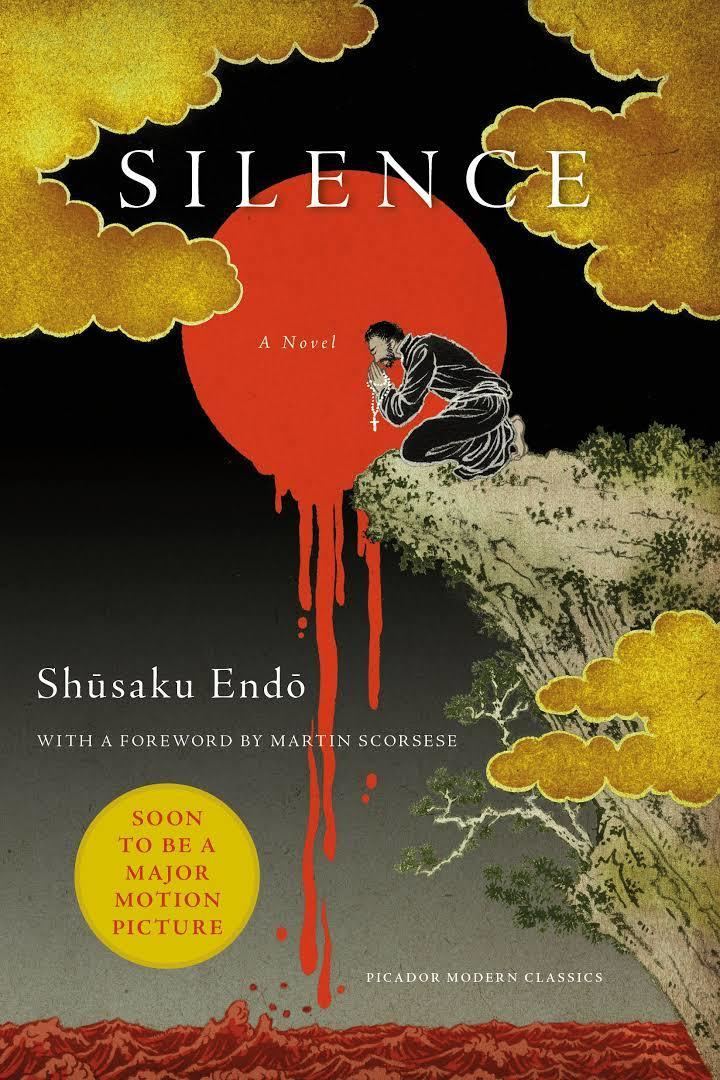8.8 /10 1 Votes
4.8/5 Barnes & Noble Translator William Johnston Publication date 1966 Originally published 1966 Adaptations Silence (2016) Published in english 1969 | 4.1/5 Goodreads Original title Chinmoku Language Japanese Published in English 1969 Genre Historical Fiction Country Japan | |||||||||||||||||||||||||||||||||
 | ||||||||||||||||||||||||||||||||||
Publisher Peter Owen (UK) / Taplinger Publishing Company (USA) Similar Shusaku Endo books, Japan books, Classical Studies books | ||||||||||||||||||||||||||||||||||
Silence (沈黙, Chinmoku) is a 1966 novel of historical fiction by Japanese author Shūsaku Endō, published in English by Peter Owen Publishers. It is the story of a Jesuit missionary sent to 17th century Japan, who endures persecution in the time of Kakure Kirishitan ("Hidden Christians") that followed the defeat of the Shimabara Rebellion. The recipient of the 1966 Tanizaki Prize, it has been called "Endo's supreme achievement" and "one of the twentieth century's finest novels". Written partly in the form of a letter by its central character, the theme of a silent God who accompanies a believer in adversity was greatly influenced by the Catholic Endō's experience of religious discrimination in Japan, racism in France, and a debilitating bout with tuberculosis.
Contents
Plot summary
The young Portuguese Jesuit Sebastião Rodrigues (based on the historical Italian figure Giuseppe Chiara) is sent to Japan to succor the local Church and investigate reports that his mentor, a Jesuit priest in Japan named Ferreira, based on Cristóvão Ferreira, has committed apostasy. Less than half of the book is the written journal of Rodrigues, while the other half of the book is written either in the third person, or in the letters of others associated with the narrative. The novel relates the trials of Christians and the increasing hardship suffered by Rodrigues.
Fr. Rodrigues and his companion Fr. Francisco Garrpe arrive in Japan in 1639. There they find the local Christian population driven underground. To ferret out hidden Christians, security officials force suspected Christians to trample on a fumi-e, a crudely carved image of Christ. Those who refuse are imprisoned and killed by anazuri (穴吊り), which is by being hung upside down over a pit and slowly bled.
Rodrigues and Garrpe are eventually captured and forced to watch as Japanese Christians lay down their lives for the faith. There is no glory in these martyrdoms, as Rodrigues had always imagined – only brutality and cruelty. Prior to the arrival of Rodrigues, the authorities had been attempting to force priests to renounce their faith by torturing them. Beginning with Fr. Ferreira, they torture other Christians as the priests look on, telling the priests that all they must do is renounce their faith in order to end the suffering of their flock.
Rodrigues' journal depicts his struggles: he understands suffering for the sake of one's own faith; but he struggles over whether it is self-centered and unmerciful to refuse to recant when doing so will end another's suffering. At the climactic moment, Rodrigues hears the moans of those who have recanted but are to remain in the pit until he tramples the image of Christ. As Rodrigues looks upon a fumi-e, Christ breaks his silence: "You may trample. You may trample. I more than anyone know of the pain in your foot. You may trample. It was to be trampled on by men that I was born into this world. It was to share men's pain that I carried my cross." Rodrigues puts his foot on the fumi-e.
An official tells Rodrigues, "Father, it was not by us that you were defeated, but by this mudswamp, Japan."
Reception
Silence received the Tanizaki Prize for the year's best full-length literature. It has also been the subject of extensive analysis. William Cavanaugh refers to the novel's "deep moral ambiguity" due to the depiction of a God who "has chosen not to eliminate suffering, but to suffer with humanity."
Endō, in his stage version of this story, The Golden Country, has the official telling Ferreira, "But the mudswamp too has its good points, if you will but give yourself up to its comfortable warmth. The teachings of Christ are like a flame. Like a flame they set a man on fire. But the tepid warmth of Japan will eventually nurture sleep." In his book A Life of Jesus, he states that Japanese culture identifies with the "one who 'suffers with us' and who 'allows for our weakness....with this fact always in mind, I tried not so much to depict God in the father-image that tends to characterize Christianity, but rather to depict the kind-hearted maternal aspect of God revealed to us in the personality of Jesus."
Adaptations
Besides Endo's stage version, The Golden Country, there have been several adaptations:
Masahiro Shinoda directed the 1971 film Silence, an adaptation from the novel.
It was re-adapted by João Mário Grilo as The Eyes of Asia in 1996.
Composer and poet Teizo Matsumura wrote the libretto and music for an opera with the same title, which was premiered at the New National Theatre in Tokyo in 2000.
The novel inspired Symphony no. 3, "Silence", composed in 2002 by Scottish musician James MacMillan.
In 2007, American film director Martin Scorsese announced his intention to direct an adaptation of the book which he had hoped to film in summer 2008. In 2009, it was announced on Empireonline.com that Daniel Day-Lewis and Benicio del Toro were signed to star in Scorsese's film adaptation. In 2013, Andrew Garfield, Liam Neeson, Issei Ogata and Ken Watanabe were attached, and the film entered production in January 2015. In 2014, Adam Driver was attached to the film adaptation. In January 2015, Watanabe was forced to leave the project due to scheduling issues and was replaced by Tadanobu Asano. The film premiered at the Pontifical Oriental Institute in Rome on November 29, 2016.
